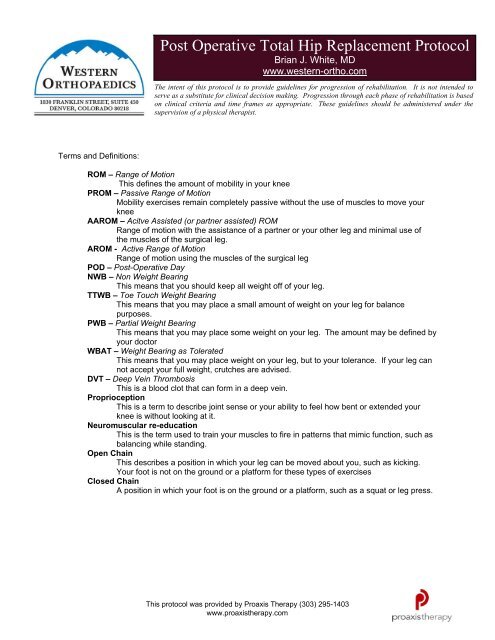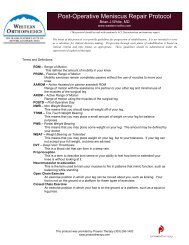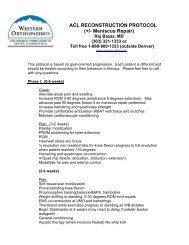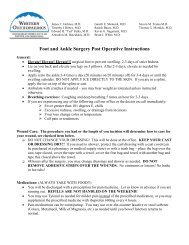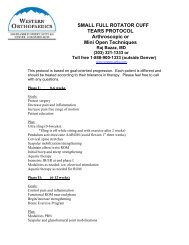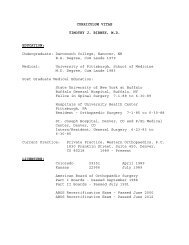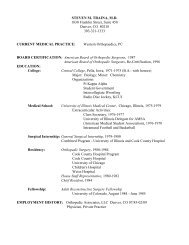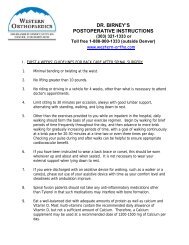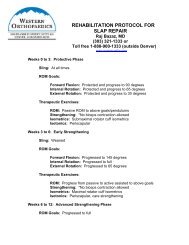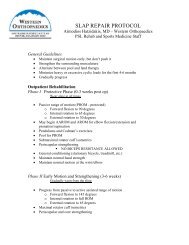Post Operative Total Hip Replacement Protocol
Post Operative Total Hip Replacement Protocol
Post Operative Total Hip Replacement Protocol
You also want an ePaper? Increase the reach of your titles
YUMPU automatically turns print PDFs into web optimized ePapers that Google loves.
<strong>Post</strong> <strong>Operative</strong> <strong>Total</strong> <strong>Hip</strong> <strong>Replacement</strong> <strong>Protocol</strong><br />
Brian J. White, MD<br />
www.western-ortho.com<br />
The intent of this protocol is to provide guidelines for progression of rehabilitation. It is not intended to<br />
serve as a substitute for clinical decision making. Progression through each phase of rehabilitation is based<br />
on clinical criteria and time frames as appropriate. These guidelines should be administered under the<br />
supervision of a physical therapist.<br />
Terms and Definitions:<br />
ROM – Range of Motion<br />
This defines the amount of mobility in your knee<br />
PROM – Passive Range of Motion<br />
Mobility exercises remain completely passive without the use of muscles to move your<br />
knee<br />
AAROM – Acitve Assisted (or partner assisted) ROM<br />
Range of motion with the assistance of a partner or your other leg and minimal use of<br />
the muscles of the surgical leg.<br />
AROM - Active Range of Motion<br />
Range of motion using the muscles of the surgical leg<br />
POD – <strong>Post</strong>-<strong>Operative</strong> Day<br />
NWB – Non Weight Bearing<br />
This means that you should keep all weight off of your leg.<br />
TTWB – Toe Touch Weight Bearing<br />
This means that you may place a small amount of weight on your leg for balance<br />
purposes.<br />
PWB – Partial Weight Bearing<br />
This means that you may place some weight on your leg. The amount may be defined by<br />
your doctor<br />
WBAT – Weight Bearing as Tolerated<br />
This means that you may place weight on your leg, but to your tolerance. If your leg can<br />
not accept your full weight, crutches are advised.<br />
DVT – Deep Vein Thrombosis<br />
This is a blood clot that can form in a deep vein.<br />
Proprioception<br />
This is a term to describe joint sense or your ability to feel how bent or extended your<br />
knee is without looking at it.<br />
Neuromuscular re-education<br />
This is the term used to train your muscles to fire in patterns that mimic function, such as<br />
balancing while standing.<br />
Open Chain<br />
This describes a position in which your leg can be moved about you, such as kicking.<br />
Your foot is not on the ground or a platform for these types of exercises<br />
Closed Chain<br />
A position in which your foot is on the ground or a platform, such as a squat or leg press.<br />
This protocol was provided by Proaxis Therapy (303) 295-1403<br />
www.proaxistherapy.com
Prehab (Presurgical Phase)<br />
Goals:<br />
• Prepare patient for surgery<br />
• Achieve optimal ROM for easier recovery<br />
• Achieve optimal conditioning for improved healing potential<br />
Interventions:<br />
• Patient education on post-operative protocol, ADL, hip precautions and<br />
ambulation with walker or crutches.<br />
•ROM, stretching and manual therapy to address ROM limitations<br />
•General conditioning (i.e. stationary bike) and light strengthening regimen<br />
Phase 1 - Inpatient Protection Phase (POD 1 - hospital discharge)<br />
Goals:<br />
• Thorough assessment of living situation, availability of caregiver, need for<br />
home care and functional and cognitive status<br />
• Patient and caregiver understanding of post-operative parameters, hip<br />
precautions, weight bearing precautions and post-operative protocol<br />
• Achieve independent ambulation with assistive device<br />
• Independent transfers (bed to stand, bathroom)<br />
• Independent with ADL with assistance of caregiver or assistive devices<br />
(hip kit)<br />
• Assist in reducing pain to tolerable levels<br />
• DVT prevention and montering<br />
<strong>Hip</strong> Precautions - maintain these precautions for ~ 3 months<br />
<strong>Post</strong>erior Dislocation Precautions – for posterior and lateral<br />
approaches<br />
Avoid isolated and combined movements of adduction, internal<br />
rotation and flexion.<br />
Limit flexion to 90º - this includes flexing the torso! (eg. Sitting and<br />
leaning forward to reach for an object)<br />
Limit hip extension to neutral<br />
Pain and Swelling<br />
• PRICE – Protection, Rest, Ice, Compression, Elevation<br />
• Use these items together to reduce pain and swelling<br />
• At minimum, 5-6 times per day for 20-30 minute sessions<br />
• There is no maximum!<br />
• Modalities as indicated - Ultrasound, Electric Stimulation,<br />
Iontophoreses<br />
This protocol was provided by Proaxis Therapy (303) 295-1403<br />
www.proaxistherapy.com
• Ankle Pumps, quad sets, glute sets, regular ambulation – for swelling<br />
and DVT prevention<br />
Range of Motion<br />
• Passive Range of Motion<br />
o Partner assisted ROM to be taught to patient and caregiver<br />
o Self ROM exercises with strap (PROM and AAROM)<br />
o Knee PROM and AROM<br />
• Active Assist Rang of Motion<br />
o Stationary Bike without resistance<br />
• Manual therapy as indicated<br />
Gait (walking) and ADL<br />
• WBAT unless otherwise noted<br />
• ADL<br />
o Supine to sit and sit to stand transfers to be instructed while<br />
maintaining hip precautions<br />
o Positioning to maintain hip precautions<br />
o Instruct toilet, car, bath and shower transfers and address living<br />
situation needs for functional mobility at home<br />
o Instruction of use of assistive devices necessary for discharge<br />
to home (eg. hip kit)<br />
Strength<br />
• Isometrics<br />
o Abduction<br />
o Adduction – may be limited with osteotomy<br />
o Flexion<br />
o Extension<br />
o Quadriceps<br />
o Hamstrings<br />
o Calf Muscles<br />
Proprioception and Neuromuscular Re-education<br />
• Begin open chain proprioception exercises<br />
• Light co-contraction exercises<br />
• Light closed chain stability balance exercises (if weight bearing status<br />
permits)<br />
This protocol was provided by Proaxis Therapy (303) 295-1403<br />
www.proaxistherapy.com
Phase 2 – Outpatient Protection Phase - (hospital discharge - post-operative week 7)<br />
Criteria to advancement to Phase 2<br />
• Independent ambulation with assistive device to distance required for<br />
discharge to home<br />
• Independent with hip precautions<br />
• Independent with post-operative protocol and HEP supplied<br />
• Caregiver and/or patient independence with ADL and transfers while<br />
maintaining hip precautions<br />
• Needs for functional mobility in living situation met<br />
• Other goals established by therapists met<br />
Goals:<br />
• Reduce swelling and pain<br />
• Restore mobility within set limitations<br />
• Promote return of strength in lower extremity musculature while<br />
maintaining hip precautions<br />
• <strong>Hip</strong> flexors, abductors, adductors, extensors<br />
• Knee extensors and flexors<br />
• Continue DVT prevention and monitoring<br />
• Restore normal gait within limits set by surgeon<br />
• Promote normal proprioceptive and neuromuscular control<br />
Pain and Swelling<br />
• PRICE – Protection, Rest, Ice, Compression, Elevation<br />
• Use these items together to reduce pain and swelling<br />
• At minimum, 5-6 times per day for 20-30 minute sessions<br />
• There is no maximum!<br />
• Modalities as indicated - Ultrasound, Electric Stimulation,<br />
Iontophoreses<br />
• Ankle Pumps, quad sets, glute sets, regular ambulation – for swelling<br />
and DVT prevention<br />
Range of Motion<br />
• Passive Range of Motion<br />
o Partner assisted ROM to be taught to patient and caregiver<br />
o Self ROM exercises with strap (PROM and AAROM)<br />
o Knee PROM and AROM<br />
• Active Assist Rang of Motion<br />
o Stationary Bike without resistance<br />
• Advance to active ROM while maintaining hip precautions<br />
• Manual therapy as indicated<br />
• Hydrotherapy<br />
o ROM exercises are permitted when incisions have healed<br />
(~2weeks)<br />
This protocol was provided by Proaxis Therapy (303) 295-1403<br />
www.proaxistherapy.com
Gait (walking) and ADL<br />
• Continue to maintain weight bearing precautions. Ambulation<br />
distances may be increased for cardio-vascular benefit. If WBAT,<br />
weaning from assistive device progression may begin as tolerated.<br />
• Weaning from crutches or walker<br />
o Begin with weight shifting exercises<br />
o Begin walking with more weight on leg using crutches<br />
o Single crutch or cane walking<br />
• This will reduce weight on your surgical leg by 25%<br />
• Be sure to place the crutch under the opposite arm<br />
o Walk small distanced in home without crutches and take<br />
crutches with you for longer distances<br />
• Hydrotherapy – water walking (may begin when incisions are healed)<br />
o Walk in water at shoulder level<br />
o Advance to walking at waist level<br />
Strength<br />
• Isometric with progression to standing, open-chain exercises<br />
o Abduction<br />
o Adduction – may be limited with osteotomy<br />
o Flexion<br />
o Extension<br />
o Quadriceps<br />
o Hamstrings<br />
o Calf Muscles<br />
Proprioception and Neuromuscular Re-education<br />
• Begin open chain proprioception exercises<br />
• Light co-contraction exercises<br />
• Light closed chain stability balance exercises (if weight bearing status<br />
permits)<br />
Phase 3 – Initial Strength (post-operative weeks 7-15)<br />
Criteria for advancement to phase 3<br />
• PROM and AROM within limitations<br />
• Minimal pain<br />
• -4/5 strength assessed in hip flexors, abductors (unless osteotomy<br />
precautions are being maintained), adductors, quads and hamstrings<br />
This protocol was provided by Proaxis Therapy (303) 295-1403<br />
www.proaxistherapy.com
Goals<br />
• Eliminate Swelling<br />
• Pain free active and passive ROM within set limitations<br />
• Restore normal gait without deviations to distance of at least 300ft. without<br />
assistive device<br />
• Increase leg strength to allow for:<br />
o Ambulation without assistive device<br />
o 1/3 knee bend without compensations<br />
o Single leg stance without Trendelenburg<br />
Swelling<br />
• Continue PRICE’ing with residual swelling<br />
• Modalities as indicated - Ultrasound, Electric Stimulation,<br />
Iontophoreses<br />
Range of Motion<br />
Continued PROM, AAROM and AROM – advance to full motion when<br />
cleared<br />
Quad and Hamstring stretching as indicated<br />
Advance to Low Load Prolonged Stretches as indicated<br />
Manual therapy as indicated for joint, capsular and soft tissue<br />
limitations.<br />
Gait (walking) and ADL<br />
• Patient is encouraged to continue weaning from assistive device if this<br />
progression has already been started<br />
• Continued use of assistive device may be necessary with gait<br />
deviations, such as antalgic gait and Trendelenburg pattern<br />
• Weaning from crutches or walker<br />
o Begin with weight shifting exercises<br />
o Begin walking with more weight on leg using crutches<br />
o Single crutch or cane walking<br />
• This will reduce weight on your surgical leg by 25%<br />
• Be sure to place the crutch under the opposite arm<br />
o Walk small distanced in home without crutches and take<br />
crutches with you for longer distances<br />
• Hydrotherapy – water walking (may begin when incisions are healed)<br />
o Walk in water at shoulder level<br />
o Advance to walking at waist level<br />
• Advance to ascending and descending stairs as tolerated<br />
Strength<br />
• <strong>Hip</strong> exercises<br />
o Sidelying open chain exercises in all directions<br />
o Theraband Around the world exercise<br />
o Side Steps with thera-band<br />
This protocol was provided by Proaxis Therapy (303) 295-1403<br />
www.proaxistherapy.com
o Single leg stance, Glute Medius exercise<br />
• Closed Chain Strength progression (Glutes and Quads)<br />
o Leg press with light weight and high repetitions beginning with<br />
double leg and advancing to single leg<br />
o Mini Squats, 1/3 knee bends<br />
o Double knee bends to 90º<br />
• Hamstring Specific Exercises<br />
o Carpet Drags<br />
o Hamstring Curls<br />
o Physio-ball bridging with knee bends<br />
• Calf Muscles<br />
o Heel-toe raising<br />
o Calf raises<br />
• Cardio<br />
o Begin stationary bike with resistance<br />
o Eliptical trainer if tolerated<br />
Proprioception, Balance and Neuromuscular Re-education<br />
• Begin double leg stability exercises on balance board<br />
• Single leg balance on stable/semi unstable (foam) surface<br />
• Single leg balance on balance board<br />
• Variations of balance exercises with perturbation training<br />
• Variations of balance exercises during alternate activity (i. e. ball<br />
tossing)<br />
Phase 4 – Advanced Strengthening (<strong>Post</strong>-<strong>Operative</strong> weeks 15- outpatient discharge)<br />
Criteria for advancement to Phase 4<br />
No residual swelling present<br />
Full Active and Passive ROM<br />
Ascending and Descending stairs with involved leg without pain or<br />
compensation<br />
At least 1 minute of double knee bends without compensations<br />
Single knee bends to 70º flexion without compensations<br />
Goals:<br />
Restore multi-directional strength<br />
Restore ability to absorb impact on leg (plyometric strength)<br />
Strength, Agility, Balance and Stability Training<br />
Increase time on double knee bends with resistance<br />
Increase time on single knee bends. Add resistance as tolerated<br />
This protocol was provided by Proaxis Therapy (303) 295-1403<br />
www.proaxistherapy.com
Forward backward jog exercises with sport cord with minimal impact<br />
Lateral Agility exercise with minimal impact<br />
Advanced perturbation, balance and stability exercises<br />
Continue with cardio training<br />
o Add treadmill walking with incline, swimming and outdoor biking<br />
as tolerated<br />
• Begin following sports at specified times or according to the discretion<br />
of surgeon and/or physical therapist<br />
oMountain biking 4-5-6 months<br />
oGolf – 5 months<br />
oSports involving running, cutting, and high-impact should be<br />
discussed with surgeon and physical therapist<br />
This protocol was provided by Proaxis Therapy (303) 295-1403<br />
www.proaxistherapy.com


